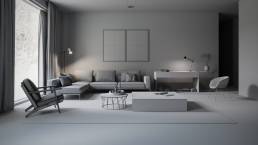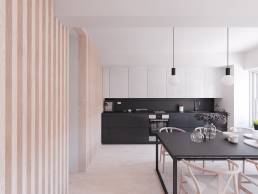In the ever-evolving landscape of architectural design, the embrace of 3D visualization represents a pivotal transformation. This technology has fundamentally altered the way architects and designers conceptualize, develop, and present their creations. No longer confined to the realms of imagination necessitated by flat, two-dimensional drawings, 3D visualization offers a dynamic and immersive experience. It brings architectural concepts to life with stunning detail and realism, ensuring that every angle and texture can be fully appreciated before a single stone is laid. This blog post aims to explore the significance, benefits, techniques, and prospects of 3D visualization in architectural design, underlining its critical role in modern architectural practices.

The evolution of 3D visualization in architectural design has been a dynamic journey, marked by technological advancements and changing industry needs. Initially, architects relied on hand-drawn sketches and physical models to convey their designs, which, while effective, had limitations in terms of flexibility and realism.
The introduction of computer-aided design (CAD) software in the late 20th century marked the first significant shift towards digital visualization. These early CAD programs allowed for 2D drafting with increasing precision but were limited in their ability to depict three-dimensional spaces realistically.
As technology advanced, so did the capabilities of visualization software. The 1990s and early 2000s saw the emergence of 3D modeling tools, enabling architects to create digital models of their designs. These models provided a more accurate representation of architectural concepts, although they were often still rendered in a somewhat rudimentary and non-photorealistic manner.
The real game-changer came with the development of advanced rendering techniques and more powerful computing hardware. This allowed for the creation of photorealistic images and animations that could accurately simulate materials, lighting, and environmental effects, offering a much clearer vision of the proposed designs.
Today, 3D visualization encompasses a wide range of technologies, including virtual reality (VR) and augmented reality (AR), which provide immersive experiences, enabling architects and clients to ‘walk through’ virtual models of their projects. These tools have not only enhanced the design and presentation processes but also improved communication and decision-making between architects, clients, and stakeholders.
In summary, the evolution of 3D visualization in architectural design has transitioned from simple 2D drawings to highly sophisticated, immersive experiences. This progression reflects broader technological advancements and highlights the industry’s ongoing quest for better tools to conceptualize, communicate, and realize architectural visions.
Why Embrace 3D Visualization in Architectural Design?

- Enhanced Communication: 3D visualization bridges the gap between architects and their clients, stakeholders, or the general public. It provides a clear, understandable representation of the proposed designs, making it easier for everyone to grasp the vision and intent behind a project.
- Improved Design Efficiency: Through 3D models, designers can experiment with elements such as light, texture, and space more freely, identifying and addressing potential issues before construction begins. This not only saves time but also significantly reduces costs associated with design modifications.
- Stakeholder Engagement: With the ability to create lifelike simulations, 3D visualization can engage stakeholders in a more meaningful way, allowing for feedback and adjustments that reflect a broader range of perspectives and needs.
The realm of 3D visualization in architectural design is both expansive and intricate, encompassing a variety of techniques and tools that enable architects and designers to bring their visions to life with stunning realism. Understanding these techniques and the software that facilitates them is crucial for anyone looking to dive deep into the world of architectural visualization.
Techniques and Tools in 3D Visualization
-
Techniques in 3D Visualization
- 3D Modeling: The cornerstone of any visualization, 3D modeling involves creating digital representations of physical objects. In architecture, this means building models of buildings, landscapes, and even interiors, piece by piece, in a virtual environment.
- Texturing and Material Mapping: This technique involves applying detailed surfaces to 3D models to give them a more realistic appearance. Textures can simulate materials like brick, glass, wood, and concrete, adding depth and realism to the models.
- Lighting: Proper lighting is essential in 3D visualization as it significantly affects the mood and realism of the scene. Techniques include natural light simulation based on geographic location and time of day, as well as artificial lighting to highlight features or create specific atmospheres.
- Rendering: Rendering transforms the 3D model into an image that includes textures, lighting, shading, and color. This process can range from simple and stylized to photorealistic, depending on the project’s needs.
- Animation: For projects that benefit from showing movement, animation can be used to simulate environmental conditions, like the movement of the sun across the sky, or to give a virtual tour of the space.
- Virtual and Augmented Reality: VR and AR are cutting-edge techniques in 3D visualization, offering immersive experiences that allow clients and designers to “walk through” a space before it’s built.

Tools for 3D Visualization
The choice of software is as important as mastering the techniques. Here are some of the most widely used tools in architectural visualization:
- Autodesk 3ds Max: Renowned for its modeling capabilities, 3ds Max is also powerful in rendering and animation, making it a popular choice for creating complex architectural visualizations.
- SketchUp: Known for its user-friendly interface, SketchUp is great for beginners and professionals alike, offering robust modeling tools with a vast library of extensions and plugins for enhanced functionality.
- Revit: Designed more for architectural design and documentation, Revit is also capable of producing detailed 3D models and visualizations, especially useful for BIM (Building Information Modeling).
- Blender: A free and open-source tool, Blender is capable of 3D modeling, texturing, rendering, and animation, making it a versatile choice for architects and designers.
- Lumion: Focused on rendering, Lumion allows for the quick creation of highly realistic images and videos, with an easy-to-use interface that is compatible with most 3D modeling software.
- V-Ray: A plugin for various 3D modeling software, V-Ray is known for its advanced rendering capabilities, offering high-quality photorealistic images.
- Unity and Unreal Engine: Though originally developed for video game creation, both Unity and Unreal Engine are increasingly used for architectural visualization, offering powerful real-time rendering and VR capabilities.
Each of these tools and techniques offers unique advantages and possibilities in the creation of 3D visualizations. The choice of which to use depends on the specific needs of the project, the desired level of realism, and the designer’s familiarity with the software. By leveraging these techniques and tools, architects and designers can produce compelling, detailed, and immersive visualizations that bridge the gap between concept and reality, ensuring that every aspect of a design is communicated effectively and understood by all stakeholders.
Benefits of 3D Visualization for Architects and Clients
3D visualization has transformed the architectural and design industries, offering an array of significant benefits for both architects and their clients. This innovative technology not only enhances the design process but also improves communication, decision-making, and marketing efforts. Here’s a closer look at the advantages of incorporating 3D visualization into architectural projects:
For Architects
- Enhanced Design Process: 3D visualization allows architects to explore and experiment with design options in a virtual environment. This flexibility makes it easier to tweak and refine designs, ensuring the final product is as close to the ideal as possible.
- Improved Communication: Traditional 2D drawings can be difficult for non-professionals to understand, but 3D visualizations present a clear and intuitive view of the proposed design. This makes it easier for architects to communicate their ideas and vision to clients, contractors, and other stakeholders.
- Error Detection and Prevention: Identifying potential design issues early in the process can save time and money. 3D models make it easier to spot clashes or design flaws, allowing for adjustments before construction begins.
- Efficient Collaboration: 3D visualization tools often come with features that support collaboration among project team members. This can include cloud-based sharing, version control, and the ability to incorporate feedback directly into the model.
- Portfolio Enhancement: High-quality 3D visuals can be a compelling addition to an architect’s portfolio, showcasing their skill and versatility in bringing complex designs to life.

For Clients
- Clear Understanding of the Project: 3D visualizations provide clients with a realistic representation of the final project, making it easier for them to visualize the space and understand the architectural vision.
- Informed Decision-Making: With a better grasp of the project details, clients can make more informed decisions regarding materials, finishes, and overall design elements. This clarity can lead to greater satisfaction with the outcome.
- Reduced Uncertainty and Anxiety: Seeing a detailed 3D visualization can alleviate concerns and reduce the anxiety clients may feel about the project’s direction, particularly in large or complex developments.
- Personalization and Feedback: 3D models allow clients to see the impact of their choices and provide feedback in real-time, ensuring their needs and preferences are accurately reflected in the final design.
- Marketing and Fundraising: For commercial clients, 3D visualizations can be a powerful marketing tool, helping to attract tenants, investors, or buyers early in the development process.
Case Studies: Success Stories of 3D Visualization
Incorporating real-life case studies can effectively illustrate the impact of 3D visualization on architectural projects. From residential buildings to complex urban developments, showcasing examples where 3D visualization played a key role in the project’s success can provide tangible proof of its value.
The Future of 3D Visualization in Architectural Design
The future of 3D visualization in architectural design promises to be an exciting fusion of emerging technologies, further blurring the lines between virtual and physical realities. As we look ahead, several key trends and innovations are poised to redefine the ways architects design, present, and interact with their creations.
1. Integration of Virtual and Augmented Reality
Virtual Reality (VR) and Augmented Reality (AR) technologies are set to become more integrated into the architectural design process. These tools will offer immersive experiences that allow clients and designers to “walk through” a project before it’s built, providing a sense of scale, depth, and spatial relationships that flat images cannot. As VR and AR devices become more accessible and user-friendly, their adoption in architectural visualization is expected to skyrocket.
2. Real-Time Rendering and Collaboration
Advancements in real-time rendering technology will enable architects and clients to see changes to designs instantaneously, making the design process more interactive and collaborative. Tools like Unreal Engine and Unity are already being adapted for architectural use, allowing for real-time visualization that can be shared across different platforms and devices, facilitating better communication and decision-making among all stakeholders.
3. AI and Machine Learning
Artificial Intelligence (AI) and machine learning are beginning to play a role in 3D visualization, offering the potential to automate certain aspects of the design process and generate more accurate models based on vast datasets of architectural elements and styles. AI could also assist in optimizing designs for environmental sustainability, structural integrity, and cost efficiency, by simulating and analyzing countless variables.
4. Cloud-Based Collaboration and Accessibility
Cloud computing will enable more seamless collaboration across the globe, allowing design teams to work together in real-time, regardless of their physical location. This will not only speed up the design process but also make high-quality 3D visualization tools more accessible to smaller firms and independent architects, democratizing high-level architectural design.
5. Enhanced Material and Environmental Simulation
Future 3D visualization tools will offer even more sophisticated simulations of materials, lighting, and environmental conditions. This includes accurate representations of how materials age over time and how buildings interact with their natural surroundings, such as changes in lighting throughout the day and seasonal variations. Such advancements will help architects design buildings that are not only aesthetically pleasing but also environmentally responsive and sustainable.
Get your project estimated within 60 minutes - simply send us your project brief!
Conclusion
The embrace of 3D visualization in architectural design marks a significant leap forward for the industry. By offering a more detailed, interactive, and understandable representation of proposed designs, 3D visualization not only enhances the design process but also fosters a deeper connection between architects, their clients, and the wider community. As technology continues to evolve, the potential of 3D visualization in transforming architectural design is limitless, promising even more exciting developments in the years to come.



